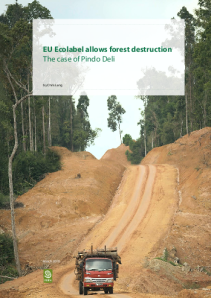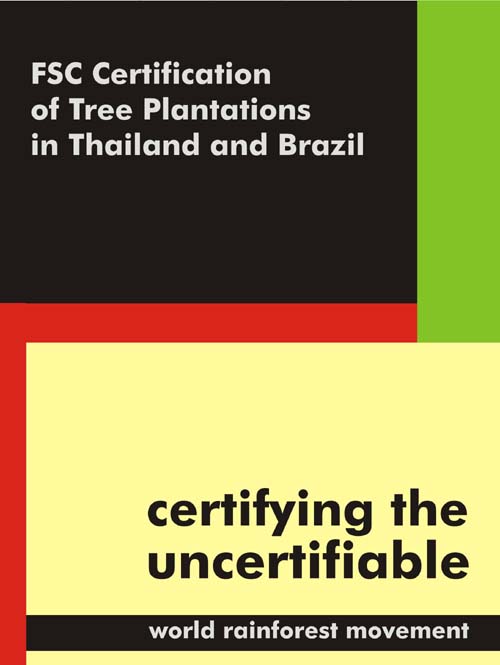Since 1994, the FACE Foundation has been planting trees in Uganda’s Mount Elgon national park, aiming to compensate for carbon emissions in the Netherlands. Despite major land disputes, the project remains certified as well managed by the Forest Stewardship Council.
By Chris Lang. Published in WRM Bulletin 101, December 2005.
Based on a presentation at an International Meeting on Plantations, 21-25 November 2005 in Vitória, Espírito Santo, Brazil (organised by WRM/FASE-ES/GJEP).
In 1994, the FACE Foundation signed an agreement with the Ugandan authorities to plant trees on 25,000 hectares inside Mount Elgon National Park in Uganda. FACE is working with the Uganda Wildlife Authority (UWA), which is responsible for the management of Uganda’s National Parks.
The FACE Foundation (Forests Absorbing Carbon dioxide Emissions) was set up in 1990 by the Dutch electricity generating board with the aim of planting trees to absorb and store carbon, supposedly to compensate for the greenhouse gas emissions from a new power station to be built in the Netherlands.
The UWA-FACE project is planting a two to three kilometre wide strip of trees just inside the 211 kilometre-long boundary of the Mount Elgon National Park. The project was certified as well managed by the Forest Stewardship Council in March 2002, after assessments in December 1999 and January 2002 by SGS Qualifor. According to SGS’s Public Summary Report of the assessment, when the assessors visited the Mount Elgon area a little over 7,000 hectares had been planted.
Fred Kizza, FACE’s project coordinator, told Timothy Byakola of the Ugandan NGO Climate and Development Initiatives that the project has improved income and standards of living in the communities near the project area. SGS says the same thing: “The project has provided significant amounts of paid labour and training to the surrounding communities in an area where there are very few other sources of paid labour.” But local council officials told Byakola that most of the jobs are only during the planting period and employ very few people. The project has taken away what little local communities had, they said. Byakola reports that forest materials required for cultural functions and firewood are hard to find. People have stopped preparing certain foods like beans that take a long time to cook. Villagers can no longer graze their goats and cows in the forest. As a result, areas near the forest are subject to overgrazing and vulnerable to soil erosion.
When Mount Elgon was declared a National Park in 1993, the people who lived within the boundaries of the National Park lost all their rights. The government evicted them from the Park, “without due compensation – something that is outrightly against the constitution of Uganda”, Byakola pointed out.
SGS’s Public Summary acknowledges that there were “disputes over park boundaries in some areas”. However, according to SGS’s assessors, “The encroachers have never had legal rights to farm the land and UWA are legally entitled to evict settlers from inside the boundary.”
UWA park rangers receive para-military training in preparation for their duties. David Wakikona, Member of Parliament for Manjiya County told New Vision in June 2004, “The boundaries were made unilaterally, displacing over 10,000 people. The wildlife people who operate there are very militarised, and have killed over fifty people. People feel that the Government favours animals more than the people.”
In July 2002, a team working on demarcating the boundary of the Park found two schools and two trading centres inside the Park. UWA’s then-chief warden, James Okonya, told the Ugandan newspaper New Vision that the encroachers would be evicted.
SGS would approve. SGS’s Public Summary acknowledges that in order for the UWA-FACE project to continue, more people will have to be evicted. SGS recommends that “more speed may be required to ensure the evictions are carried out successfully.”
In the same month that FSC issued its certificate, March 2002, several hundred families were camped in a trading centre after UWA had evicted them from their homes and land in Mount Elgon National Park. Although they had lived on Mount Elgon for over 40 years, to UWA’s armed park rangers they were squatters without land rights. Rangers destroyed houses and crops. The people evicted had to take shelter in neighbouring villages. New Vision reported that several families were living in mosques and caves. UWA evicted more than 500 families from the National Park, before being ordered to stop the evictions by the Minister of Trade, Tourism and Industry, Edward Rugumayo.
The Benet people (also known as Ndorobo) are indigenous to Mount Elgon. Having been evicted in 1983 and 1993, they decided to take the government to court to claim their land rights. In August 2003, the Uganda Land Alliance started proceedings against the Attorney General and the Uganda Wildlife Authority on behalf of the Benet. The Benet accused Uganda Wildlife Authority of constantly harassing them. The government meanwhile cut off all education and health service in the area and forbid the people from doing anything with the land.
In October 2005, Justice J.B Katutsi ruled that the Benet people “are historical and indigenous inhabitants of the said areas which were declared a Wildlife Protected Area or National Park.” He ruled that the area should be de-gazetted and that the Benet should be allowed to live on their land and continue farming it.
SGS states in its Public Summary that “The project is not planting in areas where the boundary is under dispute and the project is not engaged in any significant disputes.” But the Uganda Wildlife Authority is a part of the UWA-FACE project. It is simply not possible to separate the act of planting trees along the boundary of National Park from the management of the rest of the Park.
In February 2004, New Vision reported that police were holding 45 people “suspected of encroaching on Mount Elgon National Park and destroying 1,700 trees”. The trees were planted in 1994 under the UWA-FACE Foundation project.









